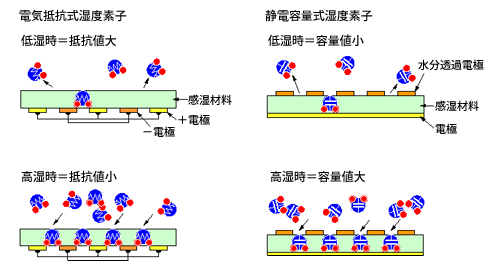Humidity expression

What exactly is the term we refer to in our daily lives as "humidity"? In a word, "humidity" is a concept that describes the amount of water vapor contained in the air (gas). So what is the difference between moisture and humidity? moisture refers to the amount of water contained in a solid or liquid. Whether it is contained in a gas or a solid is the factor that distinguishes humidity from moisture.
Humidity can be expressed in many different ways, including as a percentage. Below are some ways to express humidity:
Relative Humidity (%RH)
Usually, what we mean by "humidity" is "relative humidity," which is the amount of water vapor in the air expressed as a percentage, as in weather forecasts. More precisely, "relative humidity" is the ratio between the amount of water vapor in the air (partial pressure) and the maximum amount of water vapor that the air can contain at the same temperature (saturation water vapor pressure).
Mixing ratio (kg/kg)
Like "relative humidity," humidity is expressed as a ratio, the "mixing ratio. The "mixing ratio" is the ratio of the mass of water vapor in a gas containing water vapor to 1 kg of any gas other than water vapor (dry gas).
Absolute humidity (g/ m3)
"Absolute humidity" is the mass (g) of water vapor contained in unit volume (
1m3) of gas. Absolute humidity is equivalent to the density of water vapor, and since changes in temperature and pressure change the volume of the gas, the "absolute humidity" will change even if the amount of water vapor remains the same.
Mole fraction (mol/mol)
It is expressed as the ratio of the amount of water vapor (moles) in the air to the total amount of substance (moles).
water vapor pressure (Pa)
It represents the partial pressure of water vapor in the air.
Dew point temperature (℃)
It is expressed as the temperature at which the saturated water vapor vapor pressure of water is equal to the water vapor pressure in the air. It is the temperature at which water vapor begins to turn into water when the temperature of a gas containing water vapor is lowered.
Other ways of expressing humidity include specific humidity (kg/kg), comparative humidity (%) and frost point (℃).
Types of Hygrometers
There are various ways to measure humidity. Each has its own features such as "accuracy" and "ease of use." Below are some of the most common methods.
Wet and dry globe hygrometer
A "wet and dry bulb hygrometer" is a hygrometer with gauze (wick) attached to one of two glass thermometers that were hanging from the pillars of a house. It is composed of a dry bulb thermometer that measures temperature, and a wet bulb thermometer with gauze (wick) wrapped around the temperature-sensing part and a water pot attached to hold water to moisten the gauze (wick). Humidity is configuration from the temperature difference between the dry bulb temperature and the wet bulb temperature of these two thermometers. The wet bulb temperature is lower than the dry bulb temperature because the heat of vaporization is taken away as water evaporates from the gauze (wick). The evaporation of water depends on the relative humidity of the air in contact with it, and if the relative humidity is 100%, water will not evaporate. In other words, the lower the humidity, the more evaporation there is and the lower the wet bulb temperature will be. (Reference:
Wet bulb temperature conversion table)
A wet and dry globe hygrometer will start measuring humidity from around 20%.
A wet and dry globe hygrometer requires a great deal of know-how to consistently obtain accurate measurements, as errors can occur due to factors such as handling of the gauze (wick), sufficient ventilation, water quality, and temperature fluctuations. There is also a difficult parameter called the psychrometer constant.
Ventilated wet-bulb hygrometer

An example is the Assmann type ventilated psychrometer.
A hygrometer that forcibly blows air at 3 to 5 m/s onto the temperature-sensing part to enable more accurate humidity measurement is called a "ventilated wet-bulb hygrometer," while a hygrometer that uses a platinum resistance thermometer instead of a glass thermometer to extract an electrical signal is called an "electrical hygrometer."
Electronic hygrometer
This is a hygrometer that is widely used in industry. Electronic hygrometers are mainly classified into electrical resistance type and capacitance type. Both types utilize the adsorption of water vapor, and the higher the relative humidity, the more water vapor vapor is adsorbed. The amount of adsorbed water vapor is converted into humidity by measuring the change in electrical resistance or capacitance.
- Electrical resistance type
The electrical resistance type uses a humidity detecting element whose resistance changes depending on the relative humidity. The higher the relative humidity, the lower resistance. Please note that at low humidity levels below 20%rh, the error becomes so large that it becomes impossible to measure, and that the sensor will deteriorate at high temperatures.
- Capacitive
The capacitance type is a capacitor with thin mesh electrodes formed by vacuum deposition on both sides of a polymer film. In other words, when water vapor is adsorbed to the polymer film through the electrodes, electricity is stored in the capacitor and the change in the electric capacity (electrostatic capacitance) is detected. The amount of moisture absorption or released by the polymer film is proportional to the relative humidity of the atmosphere being measured, so the change in the amount of absorbed moisture is captured as a change in dielectric constant to measure the relative humidity.
With the capacitance type, the capacitance at 0% relative humidity is known in advance, so it is also possible to capture and measure changes in capacitance at low humidity.
- Dew point thermometer (optical)
This is currently the most accurate method for measuring humidity. The gas to be measured is introduced onto a cooled mirror, and the fogging of the mirror is detected by light reflection. The temperature of the mirror when it starts to fogging is accurately measured. By doing so, the dew point temperature td is measured directly. Also, if the temperature of the gas to be measured is measured separately, it is possible to convert the measured temperature and dew point temperature into relative humidity. Thermometers are used as standard instruments for electronic hygrometers.



